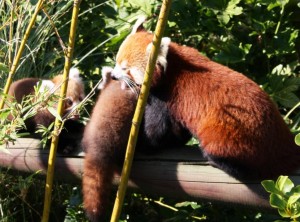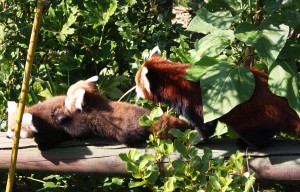Colchester Zoo is excited to report that the 20th June 2013 saw the birth of two red panda cubs; the first red panda birth for Colchester Zoo in 14 years! Colchester Zoo’s keepers hadn’t witnessed any mating, so the first time they were aware of the new arrivals was when the cubs were seen through the hatch of the nest box. As time progressed, Liwei moved the cubs between the three nest boxes within the enclosure. This is normal behaviour as, in the wild, females move their young to different nesting areas to ensure their scent does not stay around long enough for predators to become interested and to reduce the risk of tics and mites. The keepers first spotted the cubs out of the nest box on the 5th September, when Liwei brought the cubs out to explore the enclosure. The cubs are yet to be sexed and named.
Colchester Zoo’s keepers hadn’t witnessed any mating, so the first time they were aware of the new arrivals was when the cubs were seen through the hatch of the nest box. As time progressed, Liwei moved the cubs between the three nest boxes within the enclosure. This is normal behaviour as, in the wild, females move their young to different nesting areas to ensure their scent does not stay around long enough for predators to become interested and to reduce the risk of tics and mites. The keepers first spotted the cubs out of the nest box on the 5th September, when Liwei brought the cubs out to explore the enclosure. The cubs are yet to be sexed and named.
Colchester Zoo’s adult pair of pandas, male An An and female Liwei, were first mixed together in October 2012 but Liwei only reached sexual maturity at the beginning of 2013. Colchester Zoo successfully bred red pandas back in the late 1990s, with four cubs born between 1996 and 1999. To further add to the story, An An, was the son of a red panda previously held at Colchester Zoo, called Rusco, who left the collection in 2005 for Warsaw Zoo.
The red panda is from Nepal, India, Bhutan, Myanmar, southern China and north-eastern India. They live in temperate forests and are generally found at altitudes up to 4,800m. Their diet consists of mainly bamboo, yet also includes fruit, roots, succulent grasses, acorns, lichens, bird eggs, insects, and grubs. Red pandas typically give birth to between 1-4 cubs, which are born fully furred and grey in colour, developing red fur at 2-3weeks. Red pandas are nocturnal, mainly active at dawn and dusk, spending most of the day resting in the trees. In the wild, red pandas are classed as vulnerable. They are threatened by habitat loss and fragmentation, poaching, and the effects of inbreeding. 
Colchester Zoo is very pleased to be able to contribute to the European endangered Species Breeding Programme (EEP) for this species once again and hopes for more success in the future.
